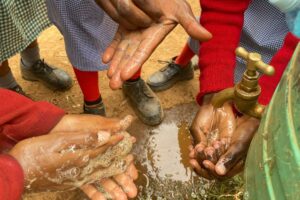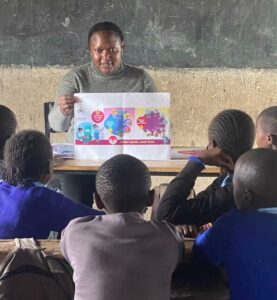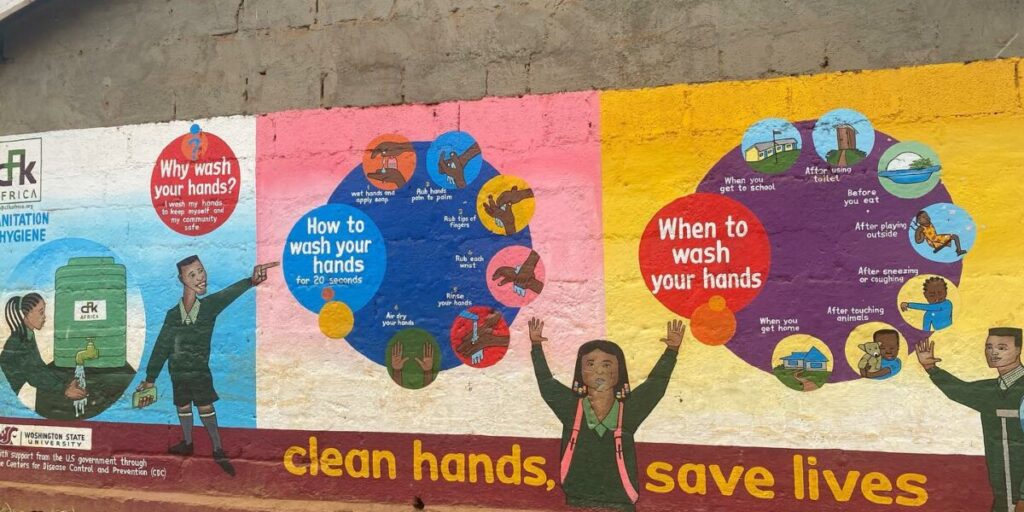Please Note: This blog has been copied with permission from CFK Africa‘s site, “Stories of Progress.” CFK Africa is an international nongovernmental organization, a registered 501(c)(3) nonprofit in the US, and an affilated entity of UNC Chapel Hill. The organization was co-founded by Tabitha Festo (a Kenyan nurse living in Kibera), Salim Mohamed (a Kenyan community organizer), and Rye Barcott (a UNC student) as “Carolina for Kibera” in 2001.
The post was written by Sarah Lebu, a CFK Africa 2022 Peacock Fellow and Ph.D. student in Environmental Science and Engineering at Gillings.
This story begins with the dong of a school bell. Immediately after, young learners, aged between six to thirteen years fill the school compound. Playgroups begin to form, lunch boxes are popped open, and happy shrieks are heard. Not too far away, a few children are washing their hands at a handwashing station by the school administration building.

Handwashing is one of the most effective ways to help prevent diarrheal-related diseases among children. In Kenya, the prevalence of diarrhea among children under 5 is 15%. The rate is even higher (18.7%) among children who live and go to school in informal settlements
Behavior Change Communication is an approach to hygiene promotion that uses an in-depth understanding of people’s behavior to design persuasive communication. At CFK Africa, children are engaged as equal and active participants in designing messaging around handwashing in schools. The design process starts by trying to understand on a deeper level how children think and feel and what motivates them to practice or not practice a behavior.
A Collaborative Design Process

Through focus group discussions with five to six children each, we created a research experience that is respectful, safe, and allowed children to share their views without fear. The groups had a varied composition: mixed-gender, mixed-age, and mixed-grade. We asked children to share their perspectives, needs, and motivations around handwashing. The process also captured nuances in design preferences around color, fonts, and choice of images used. As a CFK Peacock Fellow, I had the opportunity to facilitate two focus group discussions.
We learned that having mural designs with simple messaging, bright colors, and playful images of children were appealing to children and created a positive learning environment. The color white and sparkling hands were associated with cleanliness, while some children thought the color brown was akin to dirt and germs. The responses from children were compiled and shared with the design team to produce a child-friendly mural design.
Children as Agents of Change
To date, CFK Africa has facilitated the painting of collaboratively designed, child-friendly murals in 10 schools across two counties. The reception of the message on the murals has been positive so far. In the schools with the mural paintings, children are washing their hands more often, as often as required. We are also seeing evidence of children becoming agents of change. Young learners in schools are sharing positive hygiene messages with their near-peers (e.g., siblings and friends in the same age group). These messages are further cascading to households and communities. Such is the power of child-centered design.

However, the challenge is far from over. CFK Africa plans to work with public health officers and education officers from county governments to encourage more conversations around proper handwashing among children. For example, a training was held for members of school health clubs, dubbed WASH champions, to equip them with tools and knowledge to create more awareness among their peers on handwashing. Educators and partners working to improve hygiene among children can learn some valuable lessons from this process.
